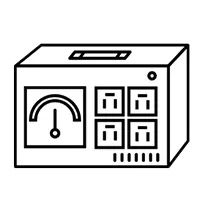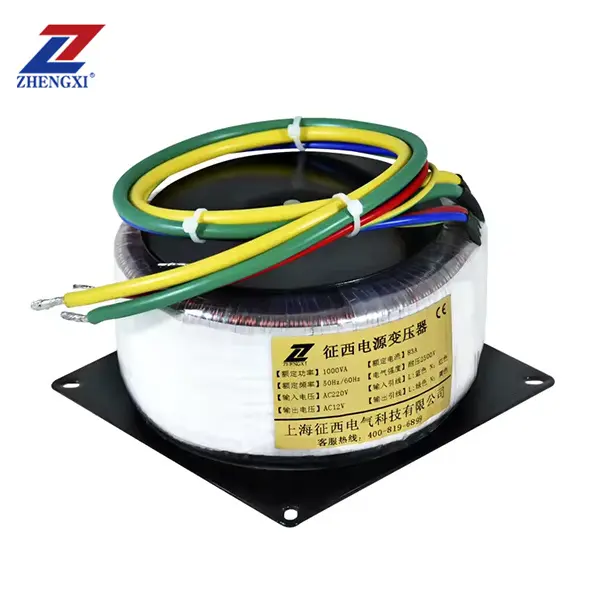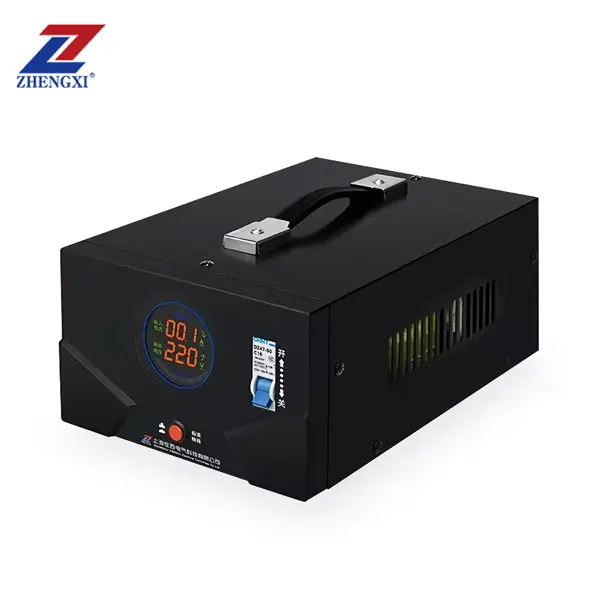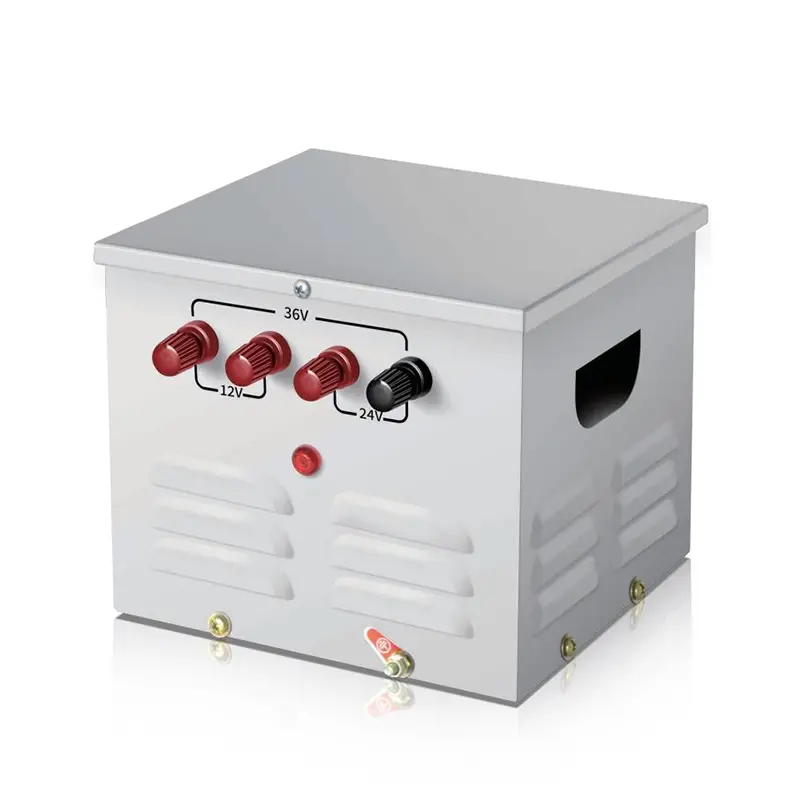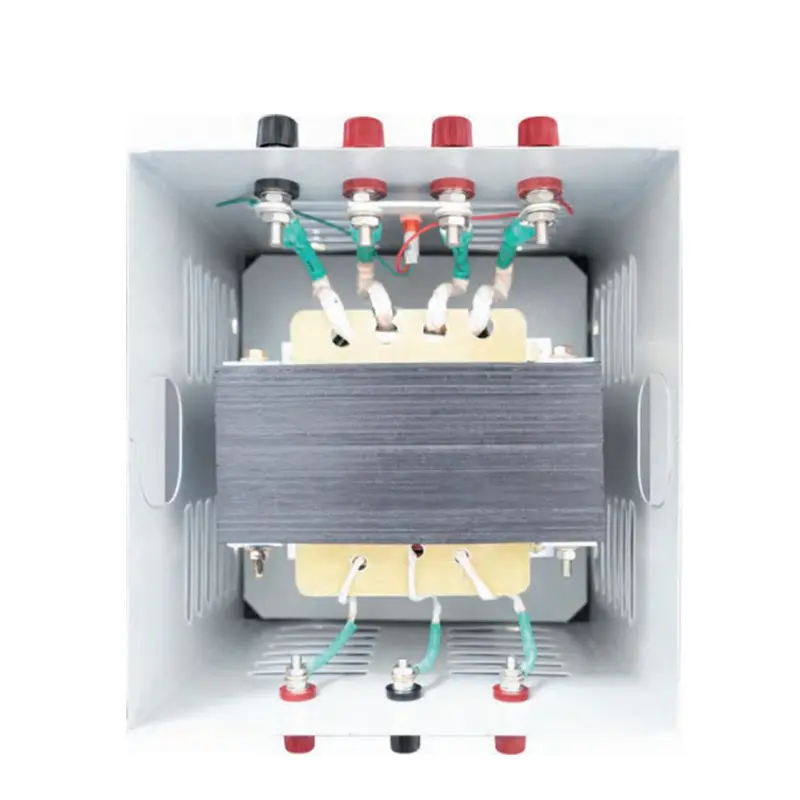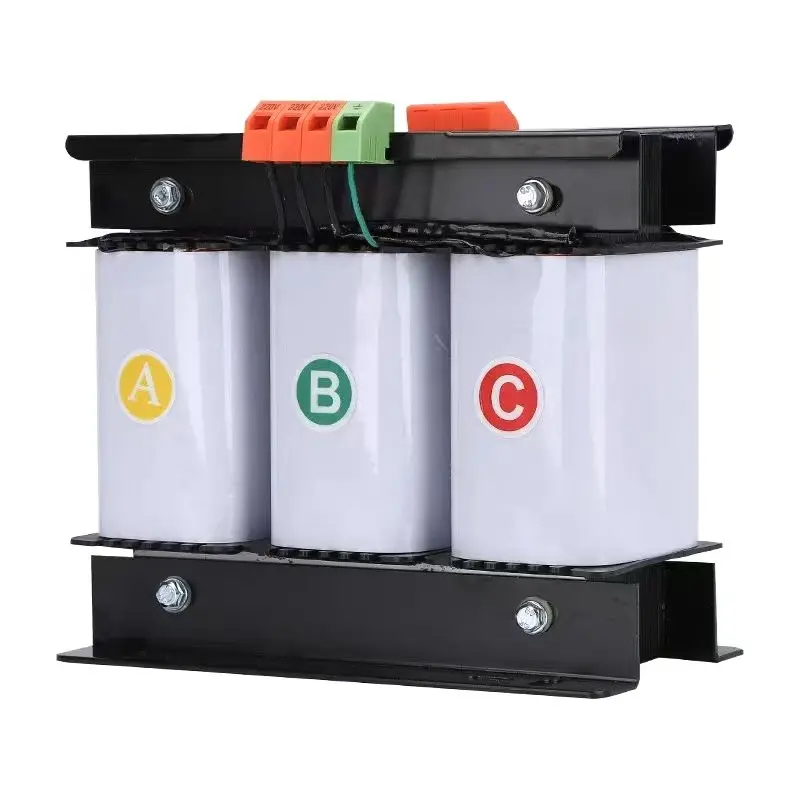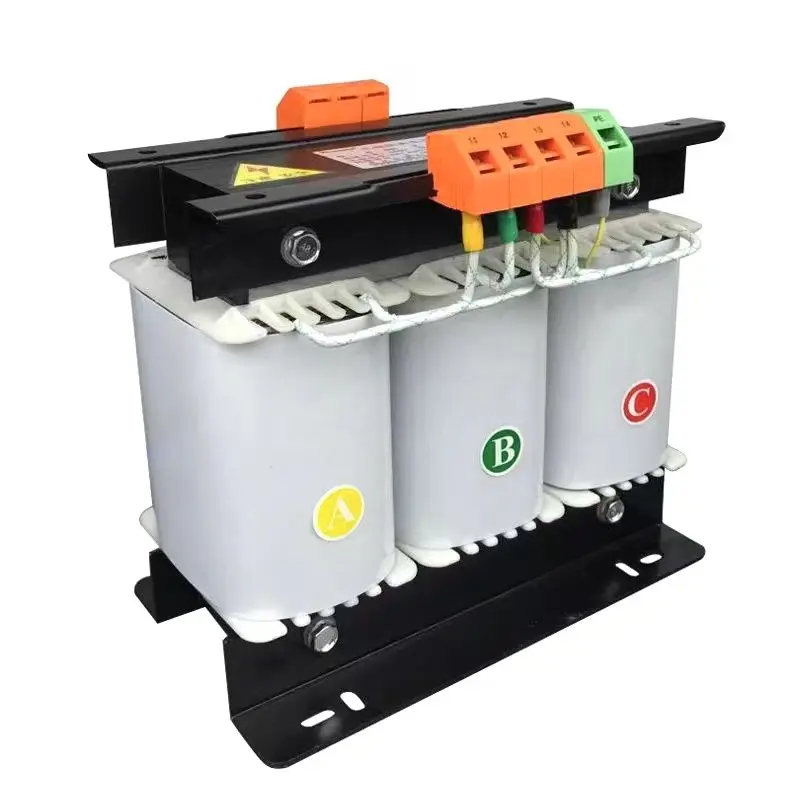يعد توصيل مستويات الجهد بكفاءة وأمان في صميم أنظمة الطاقة الحديثة - و محولات تصعيد المحولات تلعب دورًا محوريًا في رفع الفولتية المولدة للنقل لمسافات طويلة. ولكن هل المحولات التصاعدية هي بطبيعتها أجهزة ثلاثية الطور؟ في هذا الدليل الشامل، لن تكتشف الإجابة فحسب، بل ستكتشف أيضًا المفاهيم الأساسية والتطبيقات وديناميكيات السوق والتفاصيل الفنية وإرشادات الاختيار التي تحتاجها لاتخاذ قرارات مستنيرة.
شرح المفهوم الأساسي
A محول تصاعدي يزيد ("يصعّد") الجهد من لفه الأولي إلى جهد أعلى في لفه الثانوي. يقلل هذا التعزيز للجهد من التيار لنفس مستوى الطاقة، مما يقلل بدوره من خسائر النقل عبر المسافات الطويلة. من الناحية الفنية، يمكن بناء المحولات التصاعدية في كل من مرحلة واحدة و ثلاثي الطور التكوينات:
- المحولات الكهربائية أحادية الطور أحادية الطور تتكون من ملف أولي واحد وملف ثانوي واحد على قلب مغناطيسي واحد. وغالباً ما تستخدم للتطبيقات صغيرة النطاق أو عندما تتوفر طاقة أحادية الطور فقط.
- المحولات ثلاثية الأطوار ثلاثية الأطوار دمج ثلاث مجموعات من اللفات، كل منها مزاحة بمقدار 120 درجة، إما في وحدة واحدة ثلاثية الطور أو كثلاثة محولات أحادية الطور متصلة في بنك. تستفيد الوحدات ثلاثية الطور من الأحمال المتوازنة وقدرة طاقة أعلى.
في معظم أنظمة توليد الطاقة ونقلها على نطاق واسع - مثل محطات توليد الطاقة الحرارية أو المائية أو طاقة الرياح أو الطاقة الشمسية الكهروضوئية -المحولات ثلاثية الأطوار ثلاثية الأطوار هي القاعدة نظرًا لكفاءتها الفائقة، وانخفاض تكاليف المواد، وسلاسة توصيل الطاقة.

مجالات تطبيق المنتجات والتكنولوجيا
تجد المحولات التدريجية تطبيقات في أي مكان يجب فيه زيادة الفولتية المولدة من أجل كفاءة النقل أو المعدات المتخصصة:
- محطات توليد الطاقة: تنتج المولدات عادةً جهدًا في نطاق 11-25 كيلو فولت؛ وتعمل محولات التصعيد على تعزيزها إلى 110 كيلو فولت - 765 كيلو فولت لنقل الشبكة.
- مزارع الطاقة المتجددة: غالبًا ما تولد توربينات الرياح وصفائف الطاقة الشمسية الكهروضوئية طاقة متوسطة الجهد (على سبيل المثال، 690 فولت أو 33 كيلو فولت)؛ وترفع وحدات التدريج هذه الطاقة للربط البيني بشبكات النقل.
- الشبكات المصغرة الصناعية: المنشآت ذات التوليد في الموقع (التوربينات الغازية أو التوربينات المائية الصغيرة أو الكتلة الحيوية) تستخدم محولات تصعيدية للربط بالتوزيع المحلي.
- أنظمة السكك الحديدية والنقل العابر: غالبًا ما تتطلب السكك الحديدية الكهربائية جهدًا عاليًا للتيار المتردد أو التيار المستمر؛ وتقوم محولات التصعيد في المحطات الفرعية بضبط مستويات الجهد وفقًا لذلك.
- المحطات الفرعية المتنقلة والمؤقتة: توفر المحولات المحمولة ثلاثية الأطوار ثلاثية الأطوار نشرًا سريعًا لطاقة الطوارئ أو مواقع البناء النائية.
قد تتضمن محولات التصعيد الحديثة أيضًا المراقبة الذكيةمزوّد بمستشعرات مدمجة لدرجة الحرارة وتحليل الغاز المذاب (DGA) وتحديد ملامح الأحمال، مما يتيح الصيانة التنبؤية ومرونة الشبكة.
اتجاهات السوق وخلفية التنمية
الطلب على محولات تصعيد المحولات يرتبط ارتباطًا وثيقًا بالكهربة العالمية وتكامل الطاقة المتجددة وتحديث الشبكة. تشمل رؤى السوق الرئيسية ما يلي:
- إن سوق محولات الطاقة المتدرجة العالمية قُدِّرت قيمتها ب 18 مليار دولار أمريكي في عام 2023 ومن المتوقع أن تصل إلى 29 مليار دولار أمريكي بحلول عام 2032ينمو بمعدل معدل النمو السنوي المركب 5.4% داتينتلو.
- عند دمجها مع وحدات التخفيض التدريجي، فإن حجم السوق العالمية وقفت عند 10.5 مليار دولار أمريكي في عام 2024مع ارتفاع متوقع إلى 15.8 مليار دولار أمريكي بحلول عام 2033 في 5.5% CAGR 5.5% تقارير السوق التي تم التحقق من صحتها.
- وفقًا لتقرير صدر مؤخرًا عن موقع GlobeNewswire, البنية التحتية المتجددة وشحن السيارات الكهربائية هي محركات النمو الرئيسية، مما يحفز استثمارات المرافق في محولات زيادة الجهد العالي في جميع أنحاء آسيا والمحيط الهادئ وأوروبا جلوب نيوزواير.
- قيود سلسلة التوريد - التي أبرزها تحذير شركة هيتاشي للطاقة من أزمة التوريد وسط ارتفاع الطلب المتزايد - مما يؤكد أهمية الشراء المبكر وتقييم قدرات البائعين .
تسليط الضوء على المنطقة: تهيمن منطقة آسيا والمحيط الهادئ على أكثر من 301 تيرابايت و4 تيرابايت من حصة السوق، مدفوعة بالكهربة الريفية واسعة النطاق، ومزارع الطاقة الشمسية/مزارع الرياح، وشبكات النقل والتوزيع سريعة التوسع. تليها أمريكا الشمالية وأوروبا، مع التركيز على تكامل الطاقة المتجددة ومرونة الشبكة.
المعلمات التقنية والمقارنة
عند تحديد مواصفات محول تصعيد، يجب على المصممين والمشترين مراعاة ما يلي:
| المعلمة | القيم النموذجية / الملاحظات |
|---|---|
| الطاقة المقدرة (كيلو فولت أمبير - أمبير فولت أمبير) | من 100 كيلو فولت أمبير (مصادر الطاقة المتجددة الصغيرة) حتى 1,000 ميجا فولت أمبير (محطات المرافق الفرعية) |
| نسبة الجهد | على سبيل المثال، 11 كيلوفولت/400 فولت/400 فولت ⇒ 110 كيلوفولت/11 كيلوفولت؛ عادةً 33 كيلوفولت/11 كيلوفولت، 132 كيلوفولت/33 كيلوفولت |
| وصلة اللف | دلتا (Δ/Δ)، واي (Y/Y)، Δ/Y، Y/Y، Y/Δ لمرونة التصاعد والتنازل |
| طريقة التبريد | ONAN، ONAF، OFAF، OFAF، OFWF (زيت-طبيعي/هواء-قوة هواء/زيت-ماء قسري) |
| المعاوقة (%) | 4-8% (يؤثر على تنظيم الجهد وتيار العطل) |
| فئة العزل | الفئة A- الفئة H (تصنيفات عزل الزيت والورق) |
| خسائر عدم التحميل | 50-300 واط/كيلو فولت أمبير (توفر النوى غير المتبلورة منخفضة الخسارة وفورات في النفقات التشغيلية) |
| مغير الحنفية عند التحميل | "OLTC" لتنظيم الجهد في الوقت الحقيقي في ظل ظروف الحمل المتغيرة |
مقارنة مع الوحدات أحادية الطور:
- الطاقة الاستيعابية: تتعامل الوحدات ثلاثية الطور مع أحمال أكبر بكثير دون الحاجة إلى مجموعات متعددة أحادية الطور.
- كفاءة: يقلل التشغيل المتوازن ثلاثي الأطوار من الفقد في القلب والنحاس.
- البصمة: غالباً ما يشغل خزان واحد ثلاثي الطور مساحة أقل من ثلاث وحدات منفصلة أحادية الطور.
الاختلافات عن تقنيات تنظيم الجهد الأخرى
| الميزة | محول ثلاثي الأطوار ثلاثي الأطوار | منظم الجهد الساكن | مثبت الجهد المؤازر |
|---|---|---|---|
| إلكترونيات الطاقة | لا شيء (كهرومغناطيسي) | تستخدم مرددات SCRs أو IGBTs | يستخدم محرك سيرفو لضبط اللف |
| سرعة تنظيم الجهد الكهربائي | بطيء (تشغيل مغير الصنبور) | سريع (<مللي ثانية) | متوسط (بالثواني) |
| العزل | عزل جلفاني كامل | محدودة (اقتران الحالة الصلبة) | عزل كامل عبر محول كهربائي |
| التعقيد | صيانة منخفضة وتصميم مجرب | أدوات التحكم المعقدة، والمشتتات الحرارية | الأجزاء الميكانيكية تتطلب الصيانة |
| السعة المناسبة | حتى مستويات القيمة المضافة العالمية | عشرات إلى مئات كيلو فولت أمبير | مئات الكيلو فولت أمبير |
في حين أن المثبتات الثابتة والمؤازرة تتفوق في حماية الأحمال الحساسة من تقلبات الجهد، إلا أنها لا يمكن أن تحل محل محولات نقل الجهد العالي بسبب متطلبات السعة والعزل.
نصائح الشراء وإرشادات الاختيار
يتضمن اختيار المحول التصاعدي المناسب عدة اعتبارات رئيسية:
- ملف الحمل والنمو المستقبلي
- الحجم للحمل الحالي بالإضافة إلى هامش 10-20%.
- حساب التوسعات المحتملة لمزارع الطاقة المتجددة أو المحطات الفرعية الإضافية.
- مجموعة الجهد والمتجهات
- قم بمطابقة النسب الأولية/الثانوية مع جهد المولد والشبكة.
- تأكد من وجود مجموعة متجهات متوافقة (مثل Dyn11، Yd5) لمنع تحولات الطور والتيارات الدائرية.
- الكفاءة والخسائر
- اختر النوى منخفضة الخسارة (الفولاذ غير المتبلور) لتقليل النفقات التشغيلية لدورة الحياة.
- تقييم خسائر عدم التحميل والحمل المحددة في معايير IEEE C57.
- التبريد والظروف البيئية
- اختر التبريد المناسب (ONAN للخدمة العادية، ONAF أو OFWF للأحمال العالية المحيطة أو الثقيلة).
- التحقق من الملاءمة للمناطق الزلزالية أو المنشآت عالية الارتفاع.
- المعايير والشهادات
- IEC 60076-1/2، IEEE C57.12.00، ISO 9001، علامة CE، التوافق مع RoHS.
- خيارات اختبار قبول المصنع (FAT) واختبار قبول الموقع (SAT).
- الضمان والخدمة
- اطلب ≥ ضمانات لمدة عامين على الخزانات واللفائف.
- تأكد من توافر مهندسي الخدمة المحليين وقطع الغيار.
- التكلفة الإجمالية للملكية (TCO)
- ضع في الحسبان تكاليف النقل والتركيب والخسائر والصيانة ووقف التشغيل.
نصيحة: قم بإشراك البائعين الذين لديهم سجل حافل في مشاريع مماثلة واطلب أوراق بيانات فنية مفصلة وضمانات الأداء.
الأسئلة الشائعة
س1: هل المحولات التصاعدية ثلاثية الطور دائمًا؟
A: لا في حين أن وحدات تصعيد كبيرة للإرسال تكون دائمًا تقريبًا ثلاثي الطور، قد تستخدم التطبيقات الصغيرة أو ذات المولد الواحد المحولات أحادية الطور أحادية الطورخاصة عندما يتم توليد أو استخدام طاقة أحادية الطور فقط.
س2: لماذا استخدام المحولات ثلاثية الطور ثلاثية الطور بدلاً من بنوك أحادية الطور؟
A: توفر الوحدات ثلاثية الطور كفاءة أفضل, تقليل البصمة، و تحميل متوازن. فهي تبسط التركيب والصيانة مقارنةً بثلاثة محولات منفصلة أحادية الطور.
س3: كيف يمكنني الاختيار بين وصلات Δ/Y و Y/Δ؟
A: الاستخدام Δ الابتدائي-الثانوي (Δ/Y) عند زيادة جهد المولد إلى الشبكة - وهذا يوفر محايدًا لاكتشاف العطل الأرضي. Y ابتدائي-ثانوي (Y/Δ) شائع في تطبيقات التنحي حيث لا يلزم وجود محايد في جانب التوزيع.
من خلال فهم كل من مرحلة واحدة و ثلاثي الطور التكوينات، وديناميكيات السوق، والمعايير الفنية، وممارسات الاختيار المناسبة، يمكنك ضمان الأداء الأمثل والموثوقية طويلة الأجل لـ محولات تصعيد المحولات-سواء لمزرعة طاقة شمسية نائية أو شبكة نقل وطنية.
المدونات ذات الصلة
ما هو محول التحكم؟ دليل كامل للتطبيقات الصناعية
ما الفرق بين المحول التلقائي ومحول العزل؟
دليل أسعار محولات العزل ودليل الشراء
المنتجات ذات الصلة
مضخم صوت متغير عالي الجودة مخصص لمضخم الصوت المتغير الطاقة الحلقي
إن مضخم صوت متغير عالي الجودة مخصص لمضخم الصوت المتغير الطاقة الحلقي من زينغشي مصممة لتوفير دقة صوتية استثنائية وعزل كهربائي لأنظمة الصوت الاحترافية. وباعتبارها مورد المحولات الحلقية، ZHENGXI متخصصة في التصنيع محولات الصوت المخصصة التي تضمن الحد الأدنى من التشويش والتشويش المنخفض للغاية والمطابقة المثالية للمعاوقة - مثالية لمضخمات الصوت المتطورة ومعدات التسجيل وأنظمة البث وهندسة الصوت في الاستوديوهات.
على عكس محولات EI-core التقليدية, المحولات الحلقية يتميز بتصميم قلب دائري يوفر كفاءة فائقة وتداخلًا كهرومغناطيسيًا منخفضًا (EMI) واستجابة ممتازة للتردد عبر طيف صوتي يتراوح بين 20 هرتز و20 كيلو هرتز.





